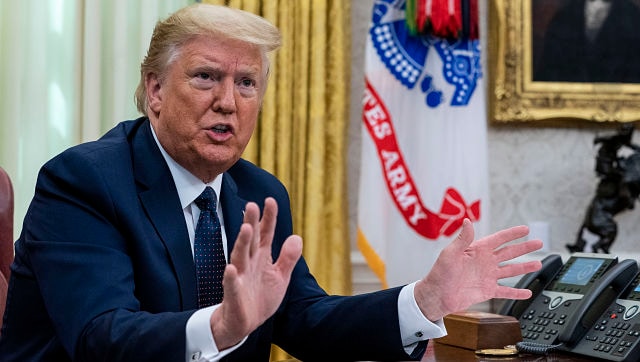Donald Trump signs Executive Order cracking down on social media, while claiming to protect 'free speech'
by The New York TimesDenouncing what he said was the power of social media “to shape the interpretation of public events,” President Donald Trump signed an Executive Order on Thursday directing federal regulators to crack down on companies like Twitter and to consider taking away the legal protections that shield them from liability for what gets posted on their platforms.
Trump and his allies have often accused Twitter as well as Facebook of bias against conservative voices, and the president has been urged for years to take a harder line against them. He had resisted until this week when Twitter fact-checked his own false statements in two posts.
That move by Twitter prompted an outcry from conservatives, who said that the platform should not be able to selectively choose whose statements it was fact-checking. But while the order sought to impose new regulatory pressure on social media companies, legal experts said it would be difficult to enforce.
“We’re here today to defend free speech from one of the greatest dangers it has faced in American history,” Trump told reporters in signing the order in the Oval Office, with William Barr, the attorney-general, standing nearby.
“They’ve had unchecked power to censure, restrict, edit, shape, hide, alter virtually any form of communication between private citizens or large public audiences,” Trump said, adding that there was “no precedent” for it. “We cannot allow that to happen, especially when they go about doing what they’re doing.”

Donald Trump speaks before signing the Executive Order on Thursday. By Doug Mills © 2020 The New York Times
Twitter, the president said, was making “editorial decisions.”
“In these moments, Twitter ceases to be a neutral public platform — they become an editor with a viewpoint,” he said, saying that Facebook and Google are included in his critiques.
With its order, the administration sought to curtail the protections currently given to technology companies under Section 230 of the Communications Decency Act, which limits the liability that companies face for content posted by their users.
The law has enabled technology companies to flourish, allowing them to mostly set their own rules for their platforms and to collect a vast amount of free content from users against which to sell ads. The Executive Order is aimed at removing that shield, Trump said.
The companies, along with many free speech advocates, have maintained that amending Section 230 would cripple online discussion and bury platforms under endless legal bills.
“We have clear content policies and we enforce them without regard to political viewpoint,” said Riva Sciuto, a Google spokeswoman. “Our platforms have empowered a wide range of people and organisations from across the political spectrum, giving them a voice and new ways to reach their audiences. Undermining Section 230 in this way would hurt America’s economy and its global leadership on internet freedom.”
Liz Bourgeois, a Facebook spokeswoman, said that “by exposing companies to potential liability for everything that billions of people around the world say, this would penalise companies that choose to allow controversial speech and encourage platforms to censor anything that might offend anyone.”
Conservative pundits have said the companies remove their posts more frequently than those of their liberal counterparts or ban them from social media services altogether.
But if protection from liability was ended, the order could end up backfiring on Trump, who has used Twitter to lob insults at rivals and to interact freely with his supporters. Without the liability shield that Section 230 provides, social media platforms could be forced to remove posts considered false or defamatory — and the president often pushes the boundaries with his commentary.
Moments after saying free speech was under attack from tech companies, Trump suggested he would shut down Twitter if it was legally possible, although he acknowledged there were substantial obstacles. But he suggested he was planning legislation dealing with social media platforms.
Administration officials initially said the Executive Order would be released Wednesday after the president said he would make an aggressive move related to social media companies. But with officials scrambling to fill in the details, the order was not released until after Trump answered questions from reporters Thursday afternoon.
Legal experts said that the enforcement actions suggested by the president were largely toothless and unlikely to withstand legal challenges.
“Regardless of the circumstances that led up to this, this is not how public policy is made in the United States. An Executive Order cannot be properly used to change federal law,” the US Chamber of Commerce said in an unusually pointed statement, one that echoed the concerns conservatives once voiced about President Barack Obama’s use of Executive Orders.
Trump’s order proposes three ways to crack down on the companies: Requiring the federal government to review its spending on social media advertisements; giving the Federal Communications Commission the authority to make new rules applying to social media platforms; and asking the Federal Trade Commission to investigate whether social media companies have misled users about the kinds of content they can post online.
It also called on states to pursue their own enforcement actions and directed the attorney general to craft a proposal for legislation.
Of the three tactics laid out in the order, the review of federal spending is the most feasible, legal experts said.
“The government does have broad authority to promote legitimate public policy goals through its spending power and it does this a lot,” said Harold Feld, a senior vice-president at Public Knowledge, a public policy nonprofit.
But withholding advertising dollars may not sway the social media companies’ behaviour. Last year, Twitter swore off political advertising altogether, and many social media companies rely heavily on major brands for their advertising dollars.
Maggie Haberman and Kate Conger c.2020 The New York Times Company